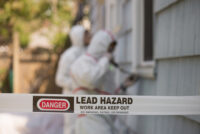The EPA recently announced it finalized stronger requirements for identifying and cleaning up lead paint dust in pre-1978 homes and childcare facilities. “There is no safe level of lead exposure, particularly for children. In children, lead can severely harm mental and physical development, slow down learning, and irreversibly damage the brain,” states an EPA news […]
On episode 176 of EHS On Tap, Zach Pucillo, EHS Compliance Manager at KPA, talks about best practices for handling hazardous materials.
The EPA continues to attempt to pass regulations banning asbestos, while industry remains committed to blocking any forthcoming laws. At this time, the only remaining form of asbestos imported into the United States is chrysotile, or “white,” asbestos, which is found in products like asbestos diaphragms, sheet gaskets, brake blocks, aftermarket automotive brakes/linings, other vehicle […]
On episode 139 of EHS On Tap, Brian Beetz, Director of Regulatory Affairs and Corporate Responsibility at Labelmaster, talks about the regulatory landscape around shipping hazardous materials.
Due to its complex nature, Tier II reporting for EPCRA can be an arduous task for EHS or operations managers to complete. Running the risk of noncompliance can have severe consequences and involve costly penalties as well as long-lasting reputational damage. Hundreds or thousands of facilities across multiple states can be a nightmare for EHS […]
Hazmat training requirements under the Pipeline and Hazardous Materials Safety Administration’s (PHMSA) regulations are nonspecific. But one thing is crystal clear: Employers are legally responsible for making sure hazmat employees are properly trained.
Chemical substances can have an assortment of labels and placards as they move through commerce and eventually end up as waste products. The Departments of Labor (DOL) and Transportation (DOT) and the Environmental Protection Agency (EPA) have regulatory authority during various points of transport, storage, use, and disposal of hazardous substances. The National Fire Protection […]
The EPA’s release of its Draft Risk Evaluation for Asbestos is a significant step in the Agency’s halting progress over more than 30 years to control the effects of one of the most carcinogenic substances in commercial use in the United States. The risk evaluation is a product of the 2016 amendments to the federal […]
Hazmat compliance. For some shippers, what is required for compliance can vary depending on their company’s point of view. On the one hand, compliance requirements can be considered tedious regulatory bureaucracy. But in today’s competitive economy, wherein efficiency counts, some shippers are taking compliance to another level and considering it a competitive edge. What made […]
A spill or release of a chemical just occurred at your facility. What do you do? Does it need to be reported? What information needs to be reported, to whom, and how soon?










